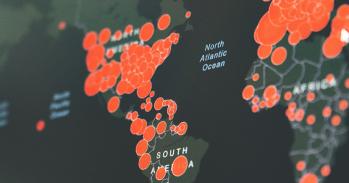
How fast could a new flu epidemic spread? The results of the UK’s largest citizen science project of its kind ever attempted, carried out by thousands of volunteers, predict that 43 million people in the UK could be infected in an influenza pandemic, and with up to 886,000 of those infected expected to be fatalities.
How fast could a new flu epidemic spread? The results of the UK’s largest citizen science project of its kind ever attempted, carried out by thousands of volunteers, predict that 43 million people in the UK could be infected in an influenza pandemic, and with up to 886,000 of those infected expected to be fatalities.
We don’t know of any studies that join up the movement and survey data so comprehensively.
Julia Gog
The numbers are frightening, but even more daunting is the very real danger of a major flu pandemic emerging at any moment. Experts around the world agree that it’s a question of when not if the next deadly pandemic will strike, making it number one on the government civilian risk register in the UK.
When it happens the pandemic will almost certainly reach the UK and the government will be faced with a series of life-saving decisions. Should we close schools or public transport? Who should be given priority when the first doses of vaccine become available? How will we cope if there is a high mortality rate? Having the right answers to these and many other crucial pandemic response questions depends on mathematical models.
The model behind the results, designed by researchers at the University of Cambridge and the London School of Hygiene and Tropical Medicine, is based on data from nearly 30,000 volunteers and represents the largest and most comprehensive dataset of its kind. The results will be broadcast on Contagion! The BBC Four Pandemic, tonight (22 March) at 9pm on BBC Four, presented by Dr Hannah Fry and Dr Javid Abdelmoneim. The results are also published in the journal Epidemics.
“The value of predictions hinges completely on the quality of the model,” said Professor Julia Gog from Cambridge’s Department of Applied Mathematics and Theoretical Physics, who heads the disease dynamics group. “Up to now, the picture of how the population in the UK move around has been surprisingly limited, and existing studies use relatively small samples of the population. Getting a handle on how people move and interact day to day is vital to understanding how a virus will actually spread from person to person and place to place. The BBC Pandemic project has aimed to address this gap, with volunteers using an app to track movements and record who they encounter day to day, creating the biggest dataset for UK pandemic research ever collected.”
“BBC Pandemic experiment has been hugely successful in recruiting study participants,” said Dr Petra Klepac, the lead author of the paper. “The resulting dataset is incredibly rich and will become a new gold standard in modelling contact and movement patterns that shape the spread of infectious diseases. For the programme, we were able to create a detailed UK model based on data from almost 30,000 users.”
The BBC Four programme will show how a pandemic might spread in the UK, starting from Haslemere in Surrey, where the team modelled in detail an introduction starting from a hypothetical patient zero.
“We don’t know of any studies that join up the movement and survey data so comprehensively,” said Gog. “And this experiment is just huge already, an order of magnitude bigger than anything even similar. The BBC Pandemic experiment sets a new benchmark for other future studies around the world.”
The study remains open during all of 2018, and anyone in the UK can volunteer by using the app (available via App Store or Google Play). Once the project is complete, the anonymised dataset will be made available to all researchers, enabling more accurate prediction in future. “Our focus so far has been on a prospective influenza pandemic, but this dataset will be valuable in our efforts to understand and control a variety of infectious diseases, both in the UK and in extrapolating to other countries,” said Gog.
“While these preliminary results are eye-opening there’s a lot more this data can be used for,” said programme host Dr Hannah Fry. “Scientists around the country will be using it for years to come.”
The BBC Pandemic app was launched in September 2017. Once downloaded, app users enter some basic anonymous demographic information about themselves such as age and gender, and then are asked to be tracked via the GPS on their phone once an hour for 24 hours. The app also records the people they come into close contact with. This is the first time tracking, demographic and contact data have been combined, making it an unrivalled tool for pandemic research.
The headline results of the simulation shown in the programme are based on a moderately transmissible influenza pandemic virus with a high fatality rate, in accordance with a ‘reasonable worst case’. The details of assumptions and limitations are discussed in detail in the paper.
Reference
Petra Klepac, Stephen Kissler and Julia Gog. ‘Contagion! The BBC Four Pandemic – the model behind the documentary.’ Epidemics (2018). DOI: 10.1016/j.epidem.2018.03.003

The text in this work is licensed under a Creative Commons Attribution 4.0 International License. For image use please see separate credits above.




